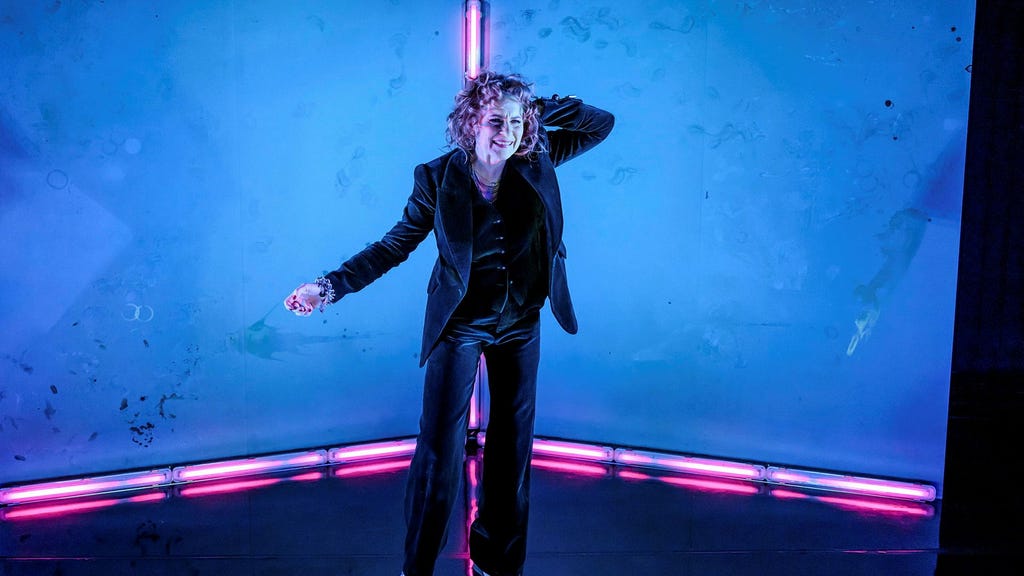Rebecka Åhlund’s memoir, ”Jag som var så rolig att dricka vin med,” (I Who Was So Fun to Drink Wine With), lays bare the insidious descent into alcoholism, a journey now brought to life on stage in a gripping one-woman performance by Sylvia Rauan. The story begins with seemingly innocuous signs: a forgotten wine bottle tucked away, increasingly frequent falls, missed appointments due to impromptu drinking sessions. These subtle red flags escalate into a full-blown addiction, marked by three bottles of wine a day and the first glass at 9 am. Åhlund’s narrative, both in the book and its theatrical adaptation, doesn’t shy away from the normalization of this destructive pattern, particularly within affluent circles where such lifestyles often remain hidden beneath a veneer of success.
Rauan masterfully embodies Åhlund’s experience, transforming the narrative from a simple recounting into a visceral exploration of a complex relationship with alcohol. Initially, the stage adaptation portrays the addiction as a passionate love affair, wine as a cherished companion, confidante, and muse. This personification of alcohol, addressed as ”you” throughout the performance, adds a layer of intimacy and dramatic tension. Rauan delivers a powerful ”break-up” speech, declaring, ”We weren’t good for each other. Or rather, you weren’t good for me.” This direct address, while initially bordering on melodramatic, ultimately serves to heighten the emotional impact of the monologue, preventing it from becoming a mere recitation of Åhlund’s journey.
Rauan’s performance transcends the potential pitfalls of a one-woman show. She deftly navigates the emotional spectrum of addiction, seamlessly transitioning from the exuberant highs of intoxication to the crippling lows of remorse and withdrawal. Her portrayal is both nuanced and raw, capturing the internal struggle with startling clarity. The minimalist staging further emphasizes Rauan’s performance, allowing the audience to fully immerse themselves in Åhlund’s story. The play, much like the book, doesn’t shy away from depicting the everyday realities of addiction, making it all the more relatable and impactful.
One of the most poignant moments in the play revolves around the impact of Åhlund’s alcoholism on her children. Rauan’s portrayal of a parent in denial, confronted with the heartbreaking pleas of her children played through a speaker system, is nothing short of devastating. This scene cuts to the core of the addict’s struggle, highlighting the profound guilt and sorrow they inflict on those closest to them. It’s not the physical consequences or societal repercussions that sting the most, but the agonizing awareness of the pain caused to loved ones, the broken promises, and the shattered trust. This resonates deeply with the audience, exposing the raw vulnerability of families grappling with addiction.
Åhlund’s eventual journey to recovery, aided by Alcoholics Anonymous, offers a glimmer of hope. The play portrays her slow, painstaking progress, emphasizing the daily struggle to maintain sobriety. However, the underlying societal issue of using substances like alcohol as a crutch to cope with life’s challenges remains largely unexplored. The play leaves the audience contemplating the broader cultural context that normalizes and even encourages such destructive coping mechanisms. This raises important questions about the societal structures that contribute to addiction and the long road towards collective healing.
The play’s strength lies in its honest and unflinching portrayal of addiction, free of romanticization or judgment. It avoids simplistic narratives and instead delves into the messy complexities of human experience. Rauan’s powerful performance brings Åhlund’s story to life with a rawness and vulnerability that resonates deeply with the audience. It’s a reminder that addiction is not a moral failing but a complex issue with far-reaching consequences, demanding empathy and understanding. The play serves as a powerful testament to the resilience of the human spirit and the possibility of recovery, while also prompting reflection on the societal factors that contribute to addiction’s pervasive grip.
The adaptation of Åhlund’s memoir is a testament to the power of storytelling to shed light on difficult and often stigmatized subjects. By bringing this personal narrative to the stage, Rauan and Novoic create a space for dialogue and understanding. The play invites the audience to confront the uncomfortable realities of addiction and contemplate the broader societal implications. It underscores the importance of seeking help and the possibility of finding a path towards recovery. The play also subtly critiques a culture that often glorifies or trivializes alcohol consumption, ultimately contributing to the normalization of harmful behaviours. By focusing on the human cost of addiction, the play leaves a lasting impact, prompting reflection long after the curtain falls.














